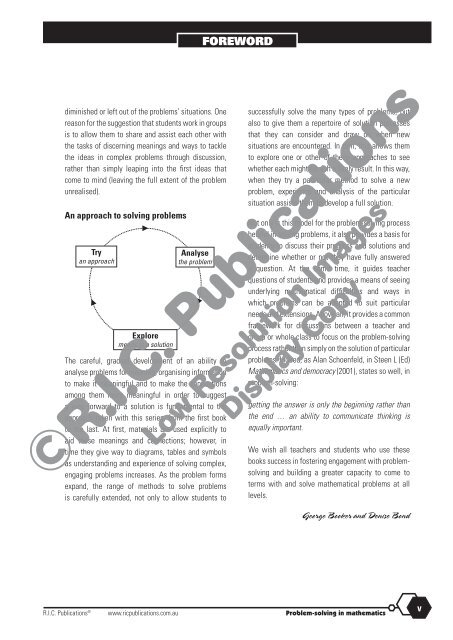20762_Problem_solving_Year_5_Number_and_place_value_2
You also want an ePaper? Increase the reach of your titles
YUMPU automatically turns print PDFs into web optimized ePapers that Google loves.
FOREWORD<br />
diminished or left out of the problems’ situations. One<br />
reason for the suggestion that students work in groups<br />
is to allow them to share <strong>and</strong> assist each other with<br />
the tasks of discerning meanings <strong>and</strong> ways to tackle<br />
the ideas in complex problems through discussion,<br />
rather than simply leaping into the first ideas that<br />
come to mind (leaving the full extent of the problem<br />
unrealised).<br />
An approach to <strong>solving</strong> problems<br />
Try<br />
an approach<br />
Explore<br />
means to a solution<br />
Analyse<br />
the problem<br />
The careful, gradual development of an ability to<br />
analyse problems for meaning, organising information<br />
to make it meaningful <strong>and</strong> to make the connections<br />
among them more meaningful in order to suggest<br />
a way forward to a solution is fundamental to the<br />
approach taken with this series, from the first book<br />
to the last. At first, materials are used explicitly to<br />
aid these meanings <strong>and</strong> connections; however, in<br />
time they give way to diagrams, tables <strong>and</strong> symbols<br />
as underst<strong>and</strong>ing <strong>and</strong> experience of <strong>solving</strong> complex,<br />
engaging problems increases. As the problem forms<br />
exp<strong>and</strong>, the range of methods to solve problems<br />
is carefully extended, not only to allow students to<br />
successfully solve the many types of problems, but<br />
also to give them a repertoire of solution processes<br />
that they can consider <strong>and</strong> draw on when new<br />
situations are encountered. In turn, this allows them<br />
to explore one or other of these approaches to see<br />
whether each might furnish a likely result. In this way,<br />
when they try a particular method to solve a new<br />
problem, experience <strong>and</strong> analysis of the particular<br />
situation assists them to develop a full solution.<br />
Not only is this model for the problem-<strong>solving</strong> process<br />
helpful in <strong>solving</strong> problems, it also provides a basis for<br />
students to discuss their progress <strong>and</strong> solutions <strong>and</strong><br />
determine whether or not they have fully answered<br />
a question. At the same time, it guides teacher<br />
questions of students <strong>and</strong> provides a means of seeing<br />
underlying mathematical difficulties <strong>and</strong> ways in<br />
which problems can be adapted to suit particular<br />
needs <strong>and</strong> extensions. Above all, it provides a common<br />
framework for discussions between a teacher <strong>and</strong><br />
group or whole class to focus on the problem-<strong>solving</strong><br />
process rather than simply on the solution of particular<br />
problems. Indeed, as Alan Schoenfeld, in Steen L (Ed)<br />
Mathematics <strong>and</strong> democracy (2001), states so well, in<br />
problem-<strong>solving</strong>:<br />
getting the answer is only the beginning rather than<br />
the end … an ability to communicate thinking is<br />
equally important.<br />
We wish all teachers <strong>and</strong> students who use these<br />
books success in fostering engagement with problem<strong>solving</strong><br />
<strong>and</strong> building a greater capacity to come to<br />
terms with <strong>and</strong> solve mathematical problems at all<br />
levels.<br />
George Booker <strong>and</strong> Denise Bond<br />
R.I.C. Publications ® www.ricpublications.com.au <strong>Problem</strong>-<strong>solving</strong> in mathematics<br />
v


















